References
enriched cited references 标识
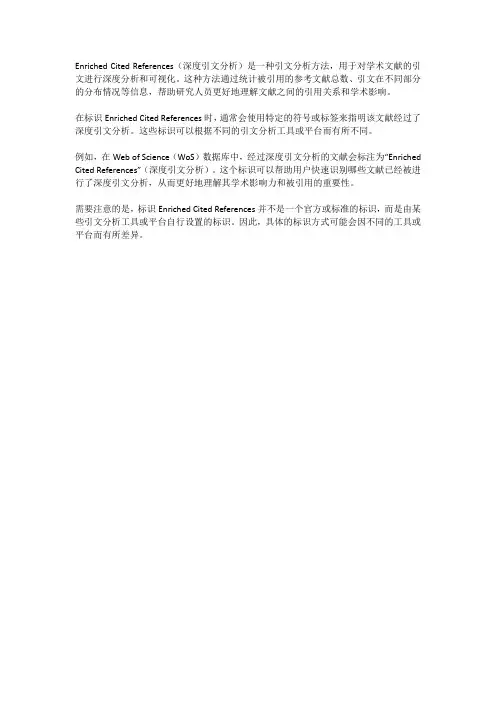
Enriched Cited References(深度引文分析)是一种引文分析方法,用于对学术文献的引文进行深度分析和可视化。
这种方法通过统计被引用的参考文献总数、引文在不同部分的分布情况等信息,帮助研究人员更好地理解文献之间的引用关系和学术影响。
在标识Enriched Cited References时,通常会使用特定的符号或标签来指明该文献经过了深度引文分析。
这些标识可以根据不同的引文分析工具或平台而有所不同。
例如,在Web of Science(WoS)数据库中,经过深度引文分析的文献会标注为“Enriched Cited References”(深度引文分析)。
这个标识可以帮助用户快速识别哪些文献已经被进行了深度引文分析,从而更好地理解其学术影响力和被引用的重要性。
需要注意的是,标识Enriched Cited References并不是一个官方或标准的标识,而是由某些引文分析工具或平台自行设置的标识。
因此,具体的标识方式可能会因不同的工具或平台而有所差异。
References
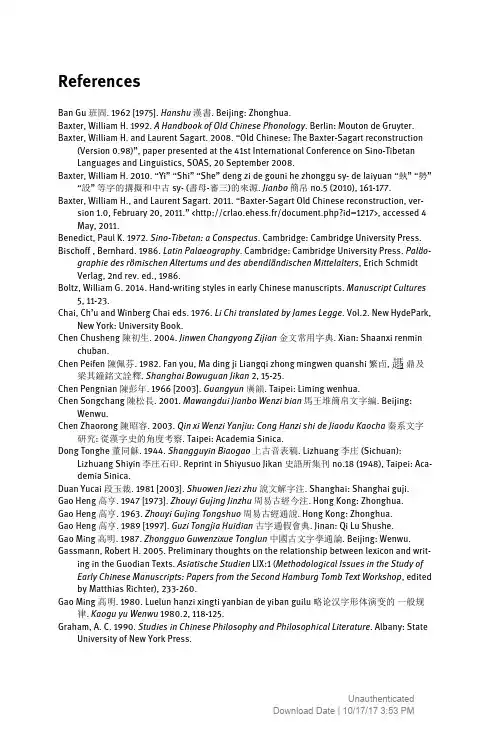
ReferencesBan Gu 班固. 1962 [1975]. Hanshu漢書. Beijing: Zhonghua.Baxter, William H. 1992. A Handbook of Old Chinese Phonology. Berlin: Mouton de Gruyter. Baxter, William H. and Laurent Sagart. 2008. “Old Chinese: The Baxter-Sagart reconstruction (Version 0.98)”, paper presented at the 41st International Conference on Sino-Tibetan Languages and Linguistics, SOAS, 20 September 2008.Baxter, William H. 2010. “Yi” “Shi” “She” deng zi de gouni he zhonggu sy- de laiyuan “埶” “勢”“設” 等字的搆擬和中古sy- (書母-審三)的來源. Jianbo簡帛no.5 (2010), 161-177. Baxter, William H., and Laurent Sagart. 2011. “Baxter-Sagart Old Chinese reconstruction, ver-sion 1.0, February 20, 2011.” <http://crlao.ehess.fr/document.php?id=1217>, accessed 4 May, 2011.Benedict, Paul K. 1972. Sino-Tibetan: a Conspectus. Cambridge: Cambridge University Press. Bischoff , Bernhard. 1986. Latin Palaeography. Cambridge: Cambridge University Press. Paläo-graphie des römischen Altertums und des abendländischen Mittelalters, Erich Schmidt Verlag, 2nd rev. ed., 1986.Boltz, William G. 2014. Hand-writing styles in early Chinese manuscripts. Manuscript Cultures 5, 11-23.Chai, Ch’u and Winberg Chai eds. 1976. Li Chi translated by James Legge. Vol.2. New HydePark, New York: University Book.Chen Chusheng 陳初生. 2004. Jinwen Changyong Zijian金文常用字典. Xian: Shaanxi renmin chuban.鼎及Chen Peifen 陳佩芬. 1982. Fan you, Ma ding ji Liangqi zhong mingwen quanshi 繁卣, 梁其鐘銘文詮釋. Shanghai Bowuguan Jikan 2, 15-25.Chen Pengnian 陳彭年. 1966 [2003]. Guangyun廣韻. Taipei: Liming wenhua.Chen Songchang 陳松長. 2001. Mawangdui Jianbo Wenzi bian馬王堆簡帛文字編. Beijing: Wenwu.Chen Zhaorong 陳昭容. 2003. Qin xi Wenzi Yanjiu: Cong Hanzi shi de Jiaodu Kaocha秦系文字研究: 從漢字史的角度考察. Taipei: Academia Sinica.Dong Tonghe 董同龢. 1944. Shangguyin Biaogao上古音表稿. Lizhuang 李庄 (Sichuan): Lizhuang Shiyin 李庄石印. Reprint in Shiyusuo Jikan 史語所集刊no.18 (1948), Taipei: Aca-demia Sinica.Duan Yucai 段玉裁. 1981 [2003]. Shuowen Jiezi zhu說文解字注. Shanghai: Shanghai guji.Gao Heng 高亨. 1947 [1973]. Zhouyi Gujing Jinzhu周易古經今注. Hong Kong: Zhonghua.Gao Heng 高亨. 1963. Zhouyi Gujing Tongshuo周易古經通說. Hong Kong: Zhonghua.Gao Heng 高亨. 1989 [1997]. Guzi Tongjia Huidian古字通假會典. Jinan: Qi Lu Shushe.Gao Ming 高明. 1987. Zhongguo Guwenzixue Tonglun中國古文字學通論. Beijing: Wenwu. Gassmann, Robert H. 2005. Preliminary thoughts on the relationship between lexicon and writ-ing in the Guodian Texts. Asiatische Studien LIX:1 (Methodological Issues in the Study of Early Chinese Manuscripts: Papers from the Second Hamburg Tomb Text Workshop, edited by Matthias Richter), 233-260.Gao Ming 高明. 1980. Luelun hanzi xingti yanbian de yiban guilu 略论汉字形体演变的一般规律. Kaogu yu Wenwu 1980.2, 118-125.Graham, A. C. 1990. Studies in Chinese Philosophy and Philosophical Literature. Albany: State University of New York Press.324 | ReferencesGuo Moruo 郭沫若. 1935. Liang Zhou Jinwen ci Daxi Kaoshi 兩周金文辭大系攷釋. Tokyo: Bunkyudo.Handel, Zev. 2012. Valence-Changing Prefixes and Voicing Alternation in Old Chinese and Proto-Sino-Tibetan: Reconstructing *s- and *N- Prefixes. Language and Linguistics 13.1, 61-82.Han Ziqiang 韓自強. 2004. Fuyang Han jian Zhouyi Yanjiu阜陽漢簡周易研究. Shanghai: Shanghai guji.He Linyi 何琳仪. 1998 [2004]. Zhanguo Guwen Zidian; Zhanguo Wenzi Shengxi戰國古文字典-戰國文字聲系. Beijing: Zhonghua.He Linyi 何琳仪. 2003. Zhanguo Wenzi Tonglun Dingbu战国文字通论订补. Nanking: Jiangsu jiaoyu.He Linyi何琳仪, Cheng Yan 程燕and Fang Zhensan 房振三. 2006. Hujian Zhouyi xuanshi (xiuding) 沪简周易选释(修订). Zhouyi Yanjiu 75 (2006, no.1), 3-6.Huang Xiquan 黃錫全. 1990. Chu xi wenzi lüe lun 楚系文字略論. Huaxia Kaogu 1990.3, 99-108. Jacques, Guillaume. 2012. An internal reconstruction of Tibetan stem alternations. Transac-tions of the Philological Society Volume 110:2 (2012), 212-224.Jiang Liangfu 姜亮夫. 1999. Guwenzi xue古文字學. Kunming: Yunnan renmin.Karlgren, Bernhard. 1954. Compendium of Phonetics in Ancient and Archaic Chinese. Bulletin of the Museum of Far Eastern Antiquities 26, 211-367.Karlgren, Bernhard. 1956. Cognate words in the Chinese phonetic series. Bulletin of the Mu-seum of Far Eastern Antiquities 28, 1-18.Karlgren, Bernhard. 1957. Grammata Serica Recensa. Stockholm: Museum of Far Eastern Antiq-uities. Reprinted from Bulletin of the Museum of Far Eastern Antiquities 29.Lai Guolong 來國龍. 2014. Shi zhen yu zhen jian shuo Chu jian “丨”zide guyun guibu ji guwenzi tongyii ziru de yizhong teshu gouxing fangshi 釋謹與慎—兼說楚簡“丨”字的古韻歸部及古文字同義字孳乳的一種特殊構形方式 . Wuhan Daxue Jianbo Yanjiu Zhongxin武漢大學簡帛研究中心 </show_article.php?id=2003> , accessed 17 June, 2014 Legge, James. n.d., preface dated 1872. The Chinese Classics with a translation, critical and ex-egetical notes, prolegomena, and copious indexes, Vol. V.-Part I. Hong Kong: London mis-sionary’s Printing office.Li Fang-kuei (F.K. Li) 李方桂. 1971 [1982]. Shangguyin Yanjiu上古音研究. Beijing: Shangwu.Li Ling 李零. 2006. Du Shangbo Chu jian Zhouyi 读上博楚简周易. Zhonguo Lishi Wenwu 2006.4, 54-67.Li Ling 李零. 2008. Shiri, rishu he yeshu-san zhong jianbo wenxian de qubie he dingming 視日,日書和葉書三種簡帛文献的區别和定名. Wenwu 2008.12, 73-80.Li Rong 李荣. 1965. Cong xiandai fangyan lun gu qunmu you yi, er, si deng 从现代方言论古群母有一,二,四等. Zhonguo yuwen 1965.5, 337-342, 355.Li Shoukui 李守奎. 2003. Chu Wenzi bian楚文字編. Shanghai: Huadong Shifan daxue.Li Xinkui 李新魁. 1982 [2006]. Yunjing Jiaozheng韻鏡校證. Beijing: Zhonghua.Li Xueqin李學勤. 1959. Zhanguo timing gaishu (shang), (zhong), (xia) 战国题铭概述 (上), (中), (下). Wenwu 1959.7, 50-54 (上), Wenwu 1959. 8, 60-63 (中), Wenwu 1959. 9, 58-61 (下).Li Xueqin 李學勤 et al. ed. 2000. Shisanjing Zhushu十三經注疏 . Beijing: Beijing Daxue chu-ban.Li Yu 李玉. 1994. Qin Han Jiandu Boshu Yinyun Yanjiu秦漢簡牘帛書音韻研究. Beijing: Dangdai zhongguo.325| ReferencesLi Yunfu 李運富. 1997. Cong wenzi de gouxing xitong kan zhanguo wenzi zai hanzi fazhanshishang de diwei 从文字的构形系统看战国文字在汉字发展史上的地位. Xuzhou ShifanDaxue Xuebao 1997.3, 35-39.Liao Mingchun 廖明春. 2001. Zhouyi Jingzhuan yu Yixue shi Xinlun周易经传与易学新论. Jinan:Qi Lu shushe.Liu Baojun 刘宝俊. 1986. Qin Han boshu yinxi gaishu 秦汉帛书音系概述. Zhongnan MinzuXueyuan Xuebao 1986.1, 126-131.Liu Xiang劉翔. 1986. Fu qi lüe shuo 簠器略說. Guwenzi Yanjiu 13, 458-463.Lu Deming 陸德明. 1985. Jingdian Shiwen經典釋文 (3 vols). Shanghai: Shanghai guji.Lü Dalin 呂大臨. 1991. Kao gu tu考古圖 (10 juan). Huang Xiaofeng 黃曉峰 edition (1753), photo-copy reprint by Jiangsu, Guangling 廣陵 guji.Ma Chengyuan 馬承源 ed. 1987-1990. Shang Zhou Qingtongqi Mingwen xuan商周青銅器銘文選. Beijing: Wenwu.Ma Chengyuan 馬承源, ed. 2001-2012. Shanghai Bowuguan cang Zhanguo Chu zhushu上海博物館藏戰國楚竹書vols. 1-9. Shanghai: Shanghai guji.Ma Chengyuan馬承源ed. 2003. Shanghai Bowugan cang Zhanguo Chu zhushu (San) 上海博物館藏戰國楚竹書 (三). Shanghai: Shanghai guji.Ma Xulun 馬叙倫. 1970. Shuowen Jiezi Yanjiu說文解字研究. Hong Kong: Taiping.Matisoff, James A. 2003. Handbook of Proto-Tibeto-Burman: System and Philosophy of Sino-Tibetan reconstruction. Berkeley and Los Angeles: University of California Press.Matisoff, James A. 2006. “Deltacism of laterals in Sino-Tibetan and elsewhere”,</pdf/JAM/DinguistDilemma-2006.pdf>, accessed on May 8,2014; a revised version of “Dinguist’s Dilemma: deltacism of laterals in Sino-Tibetan”, apaper presented at the 23rd International Conference on Sino-Tibetan Languages and Lin-guistics, University of Texas at Arlington, Oct., 3-6, 1990.Mei Tsu-lin 梅祖麟. 1979. Sino-Tibetan “year”, “month”, “foot” and “vulva”. Ch’inghuaHsuehpao new series 12.1-2, 117-134.Mei, Tsu-lin. 2012. The causative *s- and nominalizing *-s in Old Chinese and related matters inProto-Sino-Tibetan. Language and Linguistics 13.1, 1-28.Norman, Jerry. 1994. Pharyngealization in Early Chinese, Journal of the American Oriental Soci-ety 114.3, 397-408.Pan Wuyun 潘悟云. 1997. Houyinkao 喉音考. Minzu Yuwen 1997.5, 10-24.Park, Haeree. 2008. A revision of the chuan 川 phonetic series through discovered texts. Chi-nese Linguistics in Leipzig. Paris: Centre de Recherches Linguistiques sur l’Asie Orientale,39-51.Park, Haeree. 2009. The Shanghai Museum Zhouyi Manuscript and the Warring States WritingSystem. Ph.D. dissertation. University of Washington, Seattle.Park, Haeree. 2011. Shuping 书评: Zhanguo Chu fangyan yinxi 战国楚方言音系 (Review articleof Zhao Tong’s Chu Fangyan Yinxi, 2006). Yuyanxue Luncong 44, (Peking Univeristy), 356-381.Pu Maozuo 濮茅左. 2003. Transcription and annotation of the “Zhouyi 周易” in ShanghaiBowugan cang Zhanguo Chu zhushu (san)上海博物館藏戰國楚竹書 (三) edited by MaChengyuan馬承源, 131-260. Shanghai: Shanghai guji.Pulleyblank, Edwin G. 1962. The Consonantal system of Old Chinese, Part I, Asia Major New se-ries 9, 58-144.326 | ReferencesPulleyblank, Edwin G. 1978. Emphatic negatives in classical Chinese. Ancient China: Studies in Early Civilization edited by David T. Roy and Tsuen-hsuin Tsien, 115-136. Hong Kong: Chi-nese Univiversity Press.Qiu Xigui 裘锡圭. 1988 [2002]. Wenzixue Gaiyao文字学概要. Beijing: Shangwu.Qiu Xigui裘锡圭. 1992. Guwenzi Lunji古文字論集. Beijing: Zhonghua.Qiu Xigui 裘锡圭. 1998. Jiaguwen zhong de jian yu shi 甲骨文中的見與視. Jiaguwen faxian yibai zhounian xueshu yantaohui lunwenji甲骨文發現一百周年學術研討會論文集edited by Taiwan Shifan Daxue guowenxue xi and Academia Sinica, Institute of History and linguis-tics, 1-7. Taipei.Richter, Matthias. 2005. Towards a profile of graphic variation: on the distribution of graphic variants within the Mawangdui Laozi manuscript. Methodological Issues in the Study of Early Chinese Manuscripts: Papers from the Second Hamburg Tomb text Workshop, Mat-thias Richter ed., AsiatischeStudien/ Etudes Asiatiques LIX∙1∙2005. Bern: Peter Lang. Richter, Matthias, 2006. Tentative criteria for discerning individual hands in the Guodian Manuscripts. Manuscript. 28 pages. Published in: Rethinking Confucianism: Selected Pa-pers from the Third International Conference on Excavated Chinese Manuscripts, Mount Holyoke College, April 2004, edited by Xing Wen, San Antonio: Trinity University, 132-147. Richter, Matthias. forthcoming. Punctuation. Manuscript. 80 pages. To appear in Reading Early Chinese Manuscripts: Texts, Contexts, Methods, edited by Wolfgang Behr, MartinKern and Dirk Meyer. Leiden: Brill.Rong Geng 容庚. 1985 [2005]. Jinwen bian金文編. Beijing: Zhonghua.Ruan Yuan 阮元. 1980 [2003]. Shisan jing Zhushu十三經注疏. Beijing: Zhonghua.Sagart, Laurent. 2003. Sources of Middle Chinese manner types: Old Chinese pre-nasalized initials in Hmong-Mien and Sino-Tibetan perspective. Language and Linguistics 4.4, 757-768.Sagart, Laurent. 2006. On intransitive nasal prefixation in Sino-Tibetan languages. Cahiers de Linguistique – Asie Orientale 35.1, 57-70.Sagart, Laurent. 2007. “Reconstructing Old Chinese uvulars in the Baxter-Sagart system”, pa-per presented at the 40th ICSTLL, Harbin, September 27-29, 2007.Sagart, Laurent, and William H. Baxter. 2009. Reconstructing Old Chinese uvulars in the Bax-ter-Sagart system (Version 0.99). Cahiers de Linguistique – Asie Orientale 38.2, 221-244. Sagart, Laurent, and William H. Baxter. 2012. Reconstructing the *s- prefix in Old Chinese. Lan-guage and Linguistics 13.1, 29-59.Schuessler, Axel. 1974. R and L in Archaic Chinese. Journal of Chinese Linguistics 2, 186-199. Shadong sheng wenwu gongzuo weiyuanhui 山东省文物工作委员会. 1976. Houma Mengshu 侯马盟书. Shanghai: Wenwu.Shao Rongfen 邵榮芬. 1991. Xiamuzi shanggu yi fen wei er shixi 匣母上古一分爲二试析. Yuyan Yanjiu 20.1, 118-127.Shaughnessy, Edward L. 1993. I Ching 易經 (Chou I 周易). Early Chinese texts: A Bibliographical Guide edited by Michael Loewe, 216-228. Berkeley: The Society for the study of EarlyChina and the institute of East Asian studies, University of California, Berkeley. Shaughnessy, Edward L. 2006. Α first Reading of the Shanghai Museum Bamboo-Strip Manu-script of the Zhouyi, Early China 30 (2005-2006), 1-24.Shaughnessy, Edward L. 2014. Unearthing the “Changes”: Recently Discovered Manuscripts of the Yi Jing (I Ching) and Related Texts. New York: Columbia University Press.Sima Qian 司馬遷. 1959 [1962]. Shiji史記. Beijing: Zhonghua.327| ReferencesStarostin, Sergei Anatolyevich. 1989 [2010]. Gudai Hanyu Yinxi de gouni古代漢語音系的構擬(Chinese translation of Rekonstruckcija drevnekitajskoj fonologic̆e skoj sistemy. Moscow:Nauka, Glavnaja Redakcija vostoc̆n oj Literatury, 1989). Shanghai: Shanghai jiaoyu chuban上海敎育出版.Sun Shuxia 孫淑霞. 2013. Chutu Cang Jie pian gaishu 出土蒼頡篇概述. Wuhan Daxue JianboYanjiu Zhongxin 武漢大學簡帛研究中心 </show_arti-cle.php?id=1948>, accessed 6 June, 2014.Tang Lan 唐蘭. 1965. Guwenzixue Daolun古文字學導論 (2 vols). Hong Kong: Taiping.Tang Yuhui 湯余惠. 1986. Lüelun Zhanguo wenzi xingti yanjiu zhong de jige wenti 略論戰國文字形體研究中的幾個問題. Guwenzi Yanjiu 15, 9-101.Teng Rensheng 滕壬生. 2008. Chu xi Jianbo Wenzi bian, Zengding ben楚系簡帛文字編: 增訂本Wuhan: Hubeijiaoyu 湖北教育出版社.Ting Pang-hsin. 1977. Archaic Chinese *g, *gw, *γ and *γw. Monumeta Serica 33 (1977-1978),171-179.Wang Chong 王充. 1974. Lunheng論衡. Shanghai: Shanghai renmin.Wang Guowei 王國維. 1976. Shi Zhou pian Xulu史籀篇叙錄. Taipei: Taiwan Shangwu.Wang Li 王力. 2000. Wang Li Guhanyu Zidian王力古漢語字典. Beijing: Zhonghua.Watson, William. 1961. China before the Han Dynasty. New York: Frederick A. Praeger.Wu Zhenfeng 吳鎭烽. 2006. Jinwen Renming Huibian金文人名彙編. Beijing: Zhonghua.Xiao Congli 肖從禮. 2011. Qin Han jiandu “zhiri” kao 秦漢簡牘“質日”考. Fudan Daxue Guwen-xian yu Guwenzi Yanjiu Zhongxin 复旦大学古文献与古文字研究中心,</SrcShow.asp?Src_ID=1427>, accessed 4 June, 2014.Xin Ting 新亭. 2014. Qishan Zhougong miao bu jia “Wang Si Mei Ke ben yi yu miao” de guanchahe sikao 岐山周公廟卜甲“王斯妹克奔逸于廟”的觀察和思考. Fudan Daxue chutu wenxianyu guwenzi yanjiu zhongxin 复旦大学出土文献与古文字研究中心. <http://www.gwz.fu-/SrcShow.asp?Src_ID=2254>, accessed 17 June, 2014Xu Dan 徐丹. 2004. Shanggu hanyu houqi foudingci ‘wu’ daiti ‘wang’ 上古漢語後期否定詞無代替亡. Hanyu shi Xuebao 5, 64-72.Xu Xiongzhi 許雄志. 2001. Qin yin Wenzi Huibian秦印文字彙編. Zhengzhou: Henan meishu.Xu Zhongshu 徐中舒. 1981. Hanyu Guwenzi Zixing biao漢語古文字字形表. Sichuan, HongKong: Sichuan renmin, Zhonghua.Yakhontov, S. E. 1976 [1986]. Shanggu Hanyude kaitou fuyin L he R 上古汉语的开头辅音L和 Rin Hanyushi Lunji汉语史论集 edited by Tang Zuofan 唐作藩and Hu Shuangbao 胡双宝,156-165. Beijing: Beijing Daxue.Yakhontov, S. E. 1960 [1986]. Shanggu hanyude chunhua yuanyin 上古汉语的唇化元音Hanyu-shi Lunji edited by Tang Zuofan and Hu Shuangbao, 42-51. Beijing: Beijing Daxue.Zeng Xiantong 曾憲通. 1982. Santi shijing guwen yu Shuowen guwen hezheng 三體石經古文與說文古文合證. Guwenzi Yanjiu 7, 273-87.Zeng Xiantong 曾憲通. 2005. Guwenzi yu Chutu Wenxian Congkao 古文字与出土文献丛考.Guangzhou: Zhongshan daxue.Zhang Ru 张儒. 1988. Guanyu zhushu, boshu tongjiazi de kaocha 关于竹书帛书通假字的考察.Shanxi Daxue Xuebao 1988.2, 37-43.Zhang Shouzhong 張守中. 1981. Zhongshan Wang Cuo qi Wenzi bian中山王器文字編. Bei-jing: honghua.Zhang Shouzhong 張守中. 1994. Shuihudi Qin jian Wenzi bian睡虎地秦簡文字編. Beijing:Wenwu.328 | ReferencesZhang Zhenlin 張振林. 1982. Xian Qin guwenzi cailiao zhong de yuqici 先秦古文字材料中的語氣詞. Guwenzi Yanjiu 7, 289-307.Zhang Zhenglang张政烺. 1984. Mawangdui Liu shi si Gua ba 马王堆六十四卦拔. Wenwu 1984.3, 9-14.Zhao Chao 趙超. 2006. Shike Guwenzi石刻古文字. Beijing: Wenwu.Zhao Cheng 赵诚. 1986. Linyi Hanjiande tongjiazi 临沂汉简的通假字. Yinyunxue Yanjiu (er)音韵學研究edited by Zhongguo yinyunxue yanjiuhui, 17-26. Beijing: Zhonghua.Zhao Liwei 趙立偉. 2002. Shuihudi Qin mu zhujian tongjiazi yanjiu 睡虎地秦墓竹簡通假字研究. Jianbo Yuyan Wenzi Yanjiu di yi ji簡帛語言文字研究第一輯 edited by Zhang Xian-cheng 張顯成, 326-73. Chengdu: Bashu.Zhao Tong 赵彤. 2006. Zhanguo Chu Fangyan Yinxi战国楚方言音系. Beijing: Zhonguo xiju chu-banshe.Zhongguo shehui kexueyuan kaogu yanjiusuo 中國社會科學院考古研究所.1984-1994. Yin Zhou Jinwen Jicheng 殷周金文集成. Beijing: Shangwu.Zhongguo kexueyuan kaogu yanjiusuo 中國科學院考古研究所. 1965. Jiagu wen bian甲骨文編.Beijing: Zhonghua.Zhouyuan kaogu dui 周原考古隊. 2006. 2003 nian Shanxi Qishan Zhougong miao yizhi diao-cha baogao 2003年陝西岐山周公廟遺址調查報告. Gudai Wenming古代文明, vol. 5(2006), 151-186, Beijing: Wenwu.Zhou Zumo 周祖謨. 1983. Tang Wudai Yunshu Jicun唐五代韻書集存. 2 vols. Beijing: Zhong-hua.Zhou Zumo 周祖謨. 1984. Handai Zhushu yu boshu zhong de tongjiazi yu guyinde kaoding 汉代竹书与帛书中的通假字与古音的考订in Yinyunxue Yanjiu (yi) 音韵學研究(一), edited by Zhongguo yinyunxue yanjiuhui, 78-91. Beijing: Zhonghua.Zhou Zumo 周祖謨. 1993 [2004]. Fangyan Jiaojian 方言校箋. Beijing: Zhonghua.。
APA格式reference_写法

一.Reference的三种类型: 从书上引用,从杂志里的文章中引用,从网站引用1, 从书上引用的ref,格式:作者名字.年代.书名(斜体).出版社地址: 出版社名Example:Davidson, M. and Cooper, C. (1992). Shattering The Glass Ceiling: The Woman Manger. London: Paul Chapman.2, 从杂志里的文章中引用的ref,格式:作者名字.年代.文章名. 杂志名(斜体): 第几期, 页数Example:Pringle, J. (2004). Women Senior Managers: Successful Individuals Or Markers Of Collective Change. Women’s Studies Journal, 18, (2), 79-963,从网站引用的ref, 格式作者名字.年代.书名(斜体).Retrieved on年月日. from:网站Example:Adler, M. (2005). Women's Employment Concentrated In Service Industries. Retrieved on 20th September, 2005 from:.(注意: 网站另起一行)二, reference 的注意事项:1, 如果reference有两行或两行以上, 从第二行起,向内缩进五到七个字符Example:Rosener, J. (1995). America’s competitive secret: Utilizing women as a management strategy.USA: Oxford University Press.2, reference与reference中间要隔一行3文章名和杂志名:每个单词的首字母大写,虚词除外4,文章后面列出的所有reference必须与加进文章中的reference一一对应5, reference做完以后,以作者的首字为准,按字母顺序进行排列6,一般情况下,1000字,至少四个reference.这里需要强调一点:国外治学严谨,reference一定要做好!!我们的作业严禁直接抄书或从网上直接复制粘贴(这在国外被界定为抄袭)国外的学校有强大的数据库,抄袭的地方,数据库一搜就发现了一旦发现抄袭,轻则挂科,重则拿不到学位,诚信记录还要被写上一笔你可以翻译中文也可以用自己的话把句子转述一遍但是直接引用和一个句子只改2、3个单词是一样会被判抄袭的!To develop a community profile (社区分布)for one Australian Local Government Area (LGA) of your choice, (excluding the City of Boroondara) using data from the 2001 and 2006 Census available from the ABS website. The focus of the demographic profile will be to describe up to three cultural characteristics of the population within your chosen LGA, and look at changes that have occurred from 2001 to 2006.Examples of cultural characteristics are ancestry, birthplace, language spoken, year of arrival in Australia, religious affiliation, English proficiency, and indigenous status. You are expected to synthesise (综合)the information available, not just replicate (折叠,复制)the tables that you can download. For example, you may choose to group a Census table detailing individual birthplaces into categories, and then show the proportional distribution - not just the number by birthplace; or from Year of Arrival in Australia you may derive the number of years living in Australia. In other words, you are required to analyse and summarise the information you find into your own summary tables and charts. In your demographic profile you should include summary tables, charts and commentary to support the graphs and tables. You should make use of data from both the 2001 Census and the 2006 Census (e.g. using a combination QuickStats, MapStats and Census Tables.制定一个社会形象之一澳大利亚地方政府区(儿)您的选择,(不包括城市Boroondara )使用数据从2001年和2006年人口普查可从澳大利亚统计局的网站上。
英文文献的引用方法与格式
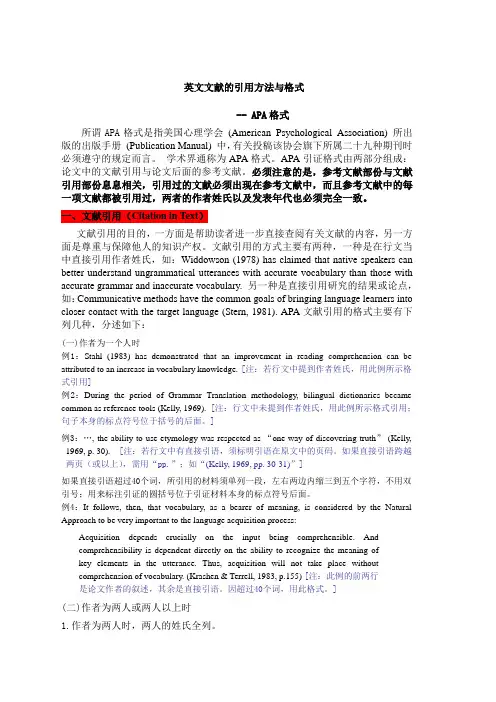
英文文献的引用方法与格式-- APA格式所谓APA格式是指美国心理学会(American Psychological Association) 所出版的出版手册(Publication Manual)中,有关投稿该协会旗下所属二十九种期刊时必须遵守的规定而言。
学术界通称为APA格式。
APA引证格式由两部分组成:论文中的文献引用与论文后面的参考文献。
必须注意的是,参考文献部份与文献引用部份息息相关,引用过的文献必须出现在参考文献中,而且参考文献中的每一项文献都被引用过,两者的作者姓氏以及发表年代也必须完全一致。
一、文献引用(Citation in Text)文献引用的目的,一方面是帮助读者进一步直接查阅有关文献的内容,另一方面是尊重与保障他人的知识产权。
文献引用的方式主要有两种,一种是在行文当中直接引用作者姓氏,如:Widdowson (1978) has claimed that native speakers can better understand ungrammatical utterances with accurate vocabulary than those with accurate grammar and inaccurate vocabulary.另一种是直接引用研究的结果或论点,如:Communicative methods have the common goals of bringing language learners into closer contact with the target language (Stern, 1981). APA文献引用的格式主要有下列几种,分述如下:(一)作者为一个人时例1:Stahl (1983) has demonstrated that an improvement in reading comprehension can be attributed to an increase in vocabulary knowledge.[注:若行文中提到作者姓氏,用此例所示格式引用]例2:During the period of Grammar Translation methodology, bilingual dictionaries became common as reference tools (Kelly, 1969). [注:行文中未提到作者姓氏,用此例所示格式引用;句子本身的标点符号位于括号的后面。
英文简历十大元素之(10)证明人References
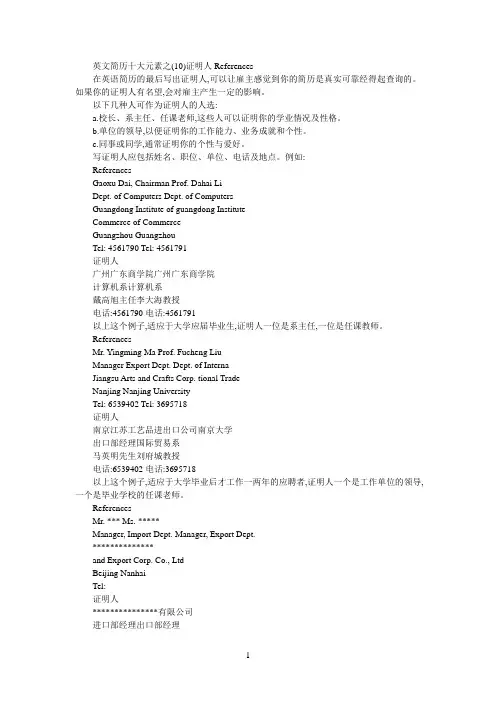
英文简历十大元素之(10)证明人References在英语简历的最后写出证明人,可以让雇主感觉到你的简历是真实可靠经得起查询的。
如果你的证明人有名望,会对雇主产生一定的影响。
以下几种人可作为证明人的人选:a.校长、系主任、任课老师,这些人可以证明你的学业情况及性格。
b.单位的领导,以便证明你的工作能力、业务成就和个性。
c.同事或同学,通常证明你的个性与爱好。
写证明人应包括姓名、职位、单位、电话及地点。
例如:ReferencesGaoxu Dai, Chairman Prof. Dahai LiDept. of Computers Dept. of ComputersGuangdong Institute of guangdong InstituteCommerce of CommerceGuangzhou GuangzhouTel: 4561790 Tel: 4561791证明人广州广东商学院广州广东商学院计算机系计算机系戴高旭主任李大海教授电话:4561790电话:4561791以上这个例子,适应于大学应届毕业生,证明人一位是系主任,一位是任课教师。
ReferencesMr. Yingming Ma Prof. Fucheng LiuManager Export Dept. Dept. of Interna-Jiangsu Arts and Crafts Corp. tional TradeNanjing Nanjing UniversityTel: 6539402 Tel: 3695718证明人南京江苏工艺品进出口公司南京大学出口部经理国际贸易系马英明先生刘府城教授电话:6539402电话:3695718以上这个例子,适应于大学毕业后才工作一两年的应聘者,证明人一个是工作单位的领导,一个是毕业学校的任课老师。
ReferencesMr. *** Ms. *****Manager, Import Dept. Manager, Export Dept.**************and Export Corp. Co., LtdBeijing NanhaiTel:证明人***************有限公司进口部经理出口部经理*****先生*****女士电话:以上这个例子,适应于已工作多年的应聘者,所以两个证明人都是自己曾经工作过的单位的负责人。
apa引用 references list
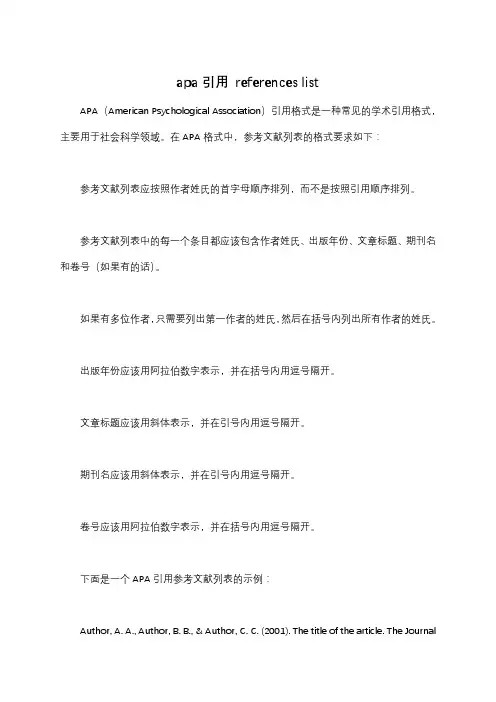
apa引用references list
APA(American Psychological Association)引用格式是一种常见的学术引用格式,主要用于社会科学领域。
在APA格式中,参考文献列表的格式要求如下:
参考文献列表应按照作者姓氏的首字母顺序排列,而不是按照引用顺序排列。
参考文献列表中的每一个条目都应该包含作者姓氏、出版年份、文章标题、期刊名和卷号(如果有的话)。
如果有多位作者,只需要列出第一作者的姓氏,然后在括号内列出所有作者的姓氏。
出版年份应该用阿拉伯数字表示,并在括号内用逗号隔开。
文章标题应该用斜体表示,并在引号内用逗号隔开。
期刊名应该用斜体表示,并在引号内用逗号隔开。
卷号应该用阿拉伯数字表示,并在括号内用逗号隔开。
下面是一个APA引用参考文献列表的示例:
Author, A. A., Author, B. B., & Author, C. C. (2001). The title of the article. The Journal
of Relevant Studies, 12(3), 1-20.
在这个示例中,参考文献列表包含一个条目,即一个期刊文章。
条目包含了作者姓氏、出版年份、文章标题、期刊名和卷号。
注意,APA格式要求在括号内使用逗号来分隔不同的信息。
数据库中references的用法
数据库中references的用法数据库中references什么是references?在数据库中,references是用于建立表与表之间关联的机制。
当一个表中的某个列(外键)引用另一个表中的主键时,我们称之为references关系。
references的作用•建立表之间的关联关系:通过使用references,可以在表之间建立关联关系,从而方便进行数据的查询和操作。
•维护数据一致性:通过定义外键关系,可以保证参照表中的数据被正确引用,避免了数据的冗余和不一致。
使用references的语法CREATE TABLE 表名 (列1 数据类型,列2 数据类型,列3 数据类型,...FOREIGN KEY (外键列) REFERENCES 参照表名 (参照列));其中,外键列对应当前表中需要引用另一个表的列,参照表名是被引用的表的名称,参照列是被引用的表中的主键列。
references的用法1.一对一关系:当两个表之间存在一对一的关系时,可以使用references来建立关联。
例如,有一个表存储员工信息,另一个表存储员工的办公室信息。
可以通过在员工表中建立外键引用办公室表的主键,来表示每个员工只能拥有一个办公室。
2.一对多关系:当一个表中的某个列需要引用另一个表中的多个行时,可以使用references来建立关联。
例如,在一个学生表中,每个学生可以有多个课程。
可以在学生表中建立外键引用课程表的主键,来表示每个学生可以参加多门课程。
3.多对多关系:当两个表之间存在多对多的关系时,需要通过中间表来建立关联。
例如,有一个商品表和一个订单表,一个商品可以出现在多个订单中,一个订单中可以包含多个商品。
可以通过在中间表中建立外键分别引用商品表和订单表的主键,来表示商品和订单之间的关系。
4.级联操作:通过定义外键的级联操作,可以自动更新或删除关联表中的数据。
例如,当删除一个课程时,可以通过设置外键的级联操作将学生表中关于该课程的记录一并删除。
sci的references格式
科学引用格式(SCI的References格式)1.引言科学引用格式(SCI)是一种用于在学术出版物中引用参考文献的标准格式。
SCI格式由美国化学学会(ACS)领导的一组学术出版组织共同制定,目的是为了使学术论文的引用标准化、规范化,方便读者查找和理解参考文献的信息。
2.SCI格式的特点SCI格式的引用特点主要包括以下几点:(1)作者姓氏在前,名字在后,用逗号隔开,而非中文的姓在前,名在后的格式。
(2)标题使用“斜体”,刊物名称用“正体”。
(3)引用的序号要用方括号括起来,而非使用括号。
这些规范的要求使得学术论文的引用信息更加清晰、规范,方便读者查找和理解引用的参考文献。
3.SCI格式的应用范围SCI格式广泛应用于自然科学和工程技术领域的学术出版物中,如物理学、化学、生物学、材料科学等领域。
SCI格式的引用标准被认为是国际上学术界最权威的引用标准之一,因此在相关领域的学术出版物中广泛使用。
4.SCI格式的引用要求SCI格式的引用要求非常严格,引用时需要按照一定的格式和顺序来列出参考文献的信息。
一般来说,SCI格式的引用要求包括以下内容:(1)作者的尊称(姓氏在前,名字在后)。
(2)文献的标题(使用斜体)。
(3)刊物的名称(使用正体)。
(4)刊物的卷号、期号和页码。
(5)出版年份。
5.SCI格式的示例以下是一篇使用SCI格式引用的参考文献示例:[1] Smith, J. A. The effects of climate change on marine ecosystems. Nature, 2015, 523(7561): 418-420.上面的引用示例中,方括号内的数字1表示引用的序号,Smith, J. A.是作者的尊称,The effects of climate change on marine ecosystems是文献的标题,Nature是刊物的名称,2015是出版年份,523是卷号,7561是期号,418-420是页码。
英语书信格式-如何提供你工作的Reference-
英语书信格式如何提供你工作的Reference?问:当潜在雇主要求我提供一份推荐人(References)的清单时,我应该提供几个人的名字?我刚毕业工作不久,而亲戚又不能算在内,没有太多选择,我该怎幺办?答:简单地说,至少提供一到两个人的姓名,而这两个人能够证明给未来的雇主你将会是个好员工。
同时这又带出了和Reference有关的几个问题。
首先是你应该找谁做Reference。
一般来说,找亲戚来证明是不适宜的。
除非你的亲戚自己主持一盘生意,而你为他/她的公司设计了一个网站进行线上交易,那又是另一码事。
你必须在你亲戚的公司中有正式的工作成绩和贡献。
除了受薪的工作以外,你还可以把自己在校参与过的项目,义务工作,其它业余活动的有说服力的人物列出来,只要这些活动能够反映你的相关业务水平。
比如你为你所在的体育俱乐部设计和维护网站,为你做义工的社区中心写了一个程序来管理信息,为你做业余老师的学校提供了电脑培训等等,这些都符合条件,而你一起工作过的人就可以做你的Reference。
其次是为你做Reference的人应该对你的表现说些什幺。
他们的评语很重要,对你的看法大体上应该一致。
最好的办法是,在你列出可以做自己Reference的名单时,给他们逐个打电话,征求他们的同意。
然后你把自己想要应聘的工作梗概,你的简历,以及你个人的一些情况发一份给每个人,让他们看过后有所参照。
在提供给未来雇主的Reference的大概格式如下:他们的姓名头衔(做什么的)在哪里工作怎么认识你的他们推荐你做哪类工作你和他们一起工作时做什么你和他们一起工作时取得的最大的成绩一起完成过的项目雇主怎么可以联络到他们。
论文reference格式写作规范
论⽂reference格式写作规范英⽂assignment的写作细节(请各位愿意长期合作的朋友,尽量仔细阅读,在⾏⽂中注意这些要求)我们的assignment通常分为两种形式,⼀是essay, ⼀是report.⼆者在形式上有所差别,essay 偏向于理论论述,report则⼤都结合case进⾏理论应⽤。
⼀篇assignment上⾯会对写成essay 还是report格式作出明确要求。
在阅读题⽬时,请尽量仔细。
相同点:1、字体:Times New Roman或者Arial, 字号:⼩四,⾏距:1.5倍。
请在写作之前就把这些格式调好,以避免写好后再调会出现⼀些意相不到的情况。
2、段与段之间隔⾏。
每段不要求像中⽂写作那样空两格,⽽是直接顶格写。
区别:Essay:Essay的写作相对report要简单⼀些。
通常只包括三个部分,Introduction, Main Body, Conclusion. Introduction 包括topic的背景介绍和论⽂的结构。
⼀般占总字数的10%左右。
Main Body是主体部分,占总字数80%左右。
如果题⽬中作了具体要求,就根据题⽬提到的⼏个⽅⾯来逐⼀讨论就可以了。
有的题⽬没有作具体要求,就根据⾃⼰的构思来写。
但要求有逻辑性。
Conclusion也是占10%,在这⼀段⾥把⽂章中的主要观点⽤⼀到两句话概括出来。
Essay的body部分不提倡⽤太多的标题,有的作业要求甚⾄会直接写明不能⽤任何的标题,所以为了保证⽂章结构的清晰性,段落间要有承上启下的句⼦,使结构清晰明了,⽂章结构很重要,⽼师⾮常重视,直接影响分数的好坏。
Reference的写作是essay和report都要涉及的,我放在最后来详细说。
Report:它的写法⼤体上和essay差不多,但要求要严格⼀些。
第⼀:标题页:顾名思义,将report的题⽬写在此页第⼆:Executive summary,是对⽂章的摘要,要把写这篇报告的⽬的(也就是为什么要写这篇报告),报告得出的结果,最后的结论,以及报告给出的建议⼀⼀交代清楚,但不需要交代题⽬背景,摘要的⽬的是让busy reader能快速掌握报告的全部内容。
- 1、下载文档前请自行甄别文档内容的完整性,平台不提供额外的编辑、内容补充、找答案等附加服务。
- 2、"仅部分预览"的文档,不可在线预览部分如存在完整性等问题,可反馈申请退款(可完整预览的文档不适用该条件!)。
- 3、如文档侵犯您的权益,请联系客服反馈,我们会尽快为您处理(人工客服工作时间:9:00-18:30)。
References[1] Shinya Nogami,“Quality Control at the Cell Level and ItsCharacteristics in the ATM Network,” Electronics and Communication in Japan, Part 1, vol.74, no.7, pp.10-21, 1991.[2] Nail Kavak,“Data Communication in ATM Networks,” IEEENetwork, pp.28-37, Jan./Feb. 1996.[3] Lars Staalhagen, “ A Comparison Between the OSI Reference Modeland the B-ISDN Protocol Reference Model,” IEEE Network, pp.24-33, Jan./Feb. 1996.[4] Tsong Ho. Wu, Dennis T. Kong, and Richard C. Lau,“ An EconomicFeasibility Study for a Broadband Virtual Path SONET/ATM Self-Healing Ring Architecture,” IEEE Journal on selected Areas in Communications, vol. 10, no. 9, pp. 1459-1473,Dec.1992.[5] David Clark, ”Are ATM, Gigabit Ethernet Ready for Prime Time,”IEEE Computer magazine, vol. 31, no. 5, pp.11-13, May 1998.[6] Norman Finn, Cisco systems, Inc. Tony Mason,“ATM LANEmulation,” IEEE Communications magazine, pp.96-100, June 1996.[7] Allyn Romanow, and Sally Floyd,“ Dynamics of TCP Traffic OverATM Networks,” IEEE Journal on selected Areas in Communications, vol. 13, no. 4, pp.633-641, Dec. 1995.[8] Flavio Bonomi and Kerry W. Fendick, “The Rate-Based Flow ControlFramework for the Available Bit Rate ATM Service,” IEEE Network, pp.25-39, March/April 1995.[9] ATM Forum Traffic Management Specification, Working Documentatm95- 0013, Jan. 1995.[10] H. T. Kung and Robert Morris, “Credit-Based flow control for ATMnetworks,” IEEE Network, pp.40-48, March/April 1995.[11] H. T. Kung, T. Blackwell, and A. Chapman, “ Credit-Based FlowControl for ATM Networks: Credit Update Protocol, Adaptive Credit Allocation, and Statistical Multiplexing,” proc. of SIGCOMM’94, London, Sep. 1994.[12] K. K. Ramakrishnan and Peter Newman, “ Integration of Rate andCredit Schemes for ATM Flow Control,” IEEE network, pp.49-56, March/April 1995.[13] Yoshio Kajiyama, Nobuyuki Tokura, and Katsuaki Kikuchi, “ An ATMVP-Based Self-Healing Ring,” IEEE Journal on Selected Areas in Communications, vol. 12, no. 1, pp.171-178, January 1994.[14] Ryutaro Kawamura ,Ken-ichi Sata and Ikuo Tokizawa, “ Self-HealingATM Networks Based on Virtual Path Concept,” IEEE Journal on Selected Areas in Communications, vol. 12, no. 1, pp.120-127, January 1994[15] Thierry van landgem, Patrick van kwikelberge, and Hany vanders traeten ,“A self-healing ATM Network Based on Multilink Principles,” IEEE Journal on Selected Areas in Communications, vol. 12, no. 1, Dec.1994.[16] Lishenghong and Liu Zemin, “A More General Traffic Model On ATMNetworks,” Proc. Of IEEE APCC/CCCS’98, Singapore, vol. 1, pp.103-106, Nov.1998.[17] D.S. Eom, M. Sugano, Murata, and H. Miyahara, “ Call AdmissionControl For QoS Provisioning in Multimedia Wireless ATM Networks,” Proc. Of IEEE APCC/CCCS’98, Singapore, vol.1, pp.14-18, Nov.1998.[18] S. S. Petrovic,“A Stochastic Traffic Management Scheme for ABRService in ATM Local Area Networks,” Proc of IEEE APCC/CCCS’98, Singapore, vol.1, pp.83-87, Nov. 1998.[19] D. Gan, and S. Mckenzie,“Traffic Policing in ATM Networks withMultimedia Traffic:The Super Leaky Bucket,” Computer Communications, vol. 22, Issue 5, pp.439-450, April 1999.[20] E. Yaprak, A. T. Chronopoulos, K. Psarris, and YiXiao, “ DynamicBuffer Allocation in an ATM Switch,” Computer Communications, vol. 31, Issue 18, pp.1927-1933, August 1999.[21] R. Handel, M. N. Huber, S. Schroder, “ATM Networks: Concepts,Protocols, Applications,” 2nd edition Addison wesly 1994.[22] J. B. Kim, T. Suda, and M. Yoshimura, “International Standardizationof B-ISDN,” Computer Networks and ISDN Systems, vol. 27, 1994.[23] CCITT Recommendation I-Series.[24] W. Stallings, “Networking Standards: A guide to OSI, ISDN, LAN,and MAN Standards,” Addison wesly 1993.[25] George C. Sackett and Christopher Y. Metz, “ ATM and MultiprotocolNetworking,” McGraw-Hill Companies, 1997.[26] Art Edmonds, Jr, “ATM Network Planning and Implementation,”International Thomson Computer Press, 1997.[27] CCITT Recommendation G-Series.[28] W. Stallings, “ISDN and Broadband ISDN with Frame Relay andATM,” Prentice-Hall International, Inc., 1995.[29] F. Fluckiger,“Understanding Networked Multimedia Applicationsand Technology,” Prentice Hall, First Edition, 1995.[30] David M. Drury, " ATM traffic management and the impact of ATMswitch design,” Computer Networks and ISDN systems 28, pp.471-479, (1996).[31] Tim Kwok,"Avision for Residential Broadband Services: ATM-to-The-Home,” IEEE Network, pp.14-28, Sept./Oct.1995.[32] G. Wallaco, "The JPEG Still Picture Compression Standard,”Commun. of the ACM, vol. 34, no. 4, pp.30-44, April 1991.[33] Jan Crowcroft, Zheng Wang, Avril Smith, and John Adams, " A RoughComparison of the IETF and ATM Service Models," IEEE Network, pp.12-16, Nov./Dec. 1995.[34] Mark W. Garrett, “ A Service Architecture for ATM: FromApplication to Scheduling,” IEEE Network, pp.6-14, May/June 1996.[35] Sudhir Dixit and Paul Skelly, " MPEG-2 over ATM for Video DialTone Networks: Issues and strategies,” IEEE Network, pp.30-40, Sept./Oct.1995.[36] P. V. Rangan, S. Kumar, and S. Rajan, “ Continuity andSynchronization in MPEG,” IEEE J. on Selected Area in Comm., Vol.14, No. 1, pp.52-60, Jan 1996.[37] P. Wong, and T. Peter, “An Integrated Services Token ControlledRing Network,” IEEE J. Select. A reas Commun., Vol. 7, No. 5, pp.670-679, June 1989.[38] Mostafa H. Ammar, Victor O.K. Li, Mehmet Ulema, “ Broadband ISDN:Standards, Switches, and Traffic Management,” Computer Networks and ISDN system 27(1994), pp.1411-1427 (1-3).[39] William Stallings, “Data and Computer Communications,” 2nd editionMacmillan Publishing Company, 1989.[40] ITU/CCITT, “H.261: Video CODEC for Audio visual service at P X64 Kbps,” Geneva, 1990.[41] Ismail Dalgic, and Fouad A. Tobagi “Constant Quality Video Encoding”, IEEE Proceeding ICC’95, Seattle, Washington, pp.1-7, June 1995. [42] International Organization for Standardization (ISO),”MPEG: Coding ofmoving Pictures and Associated Audio for Digital storage Media At up to About 1.5 Mbps,” Nov. 1991.[43] I. Dalgic, W. Chien, and F. Tobagi,“Evaluation of 10Base-T and100Base-T Ethernets Carrying Video, Audio and Data Traffic,”IEEE INFOCOM 94 Proceeding, Tronto, Canada, pp.1-9, June 1994.[44] Ciro A. Noronha Jr, and Fouad A. Tobagi, “Evaluation of multicastrouting algorithms for multimedia streams,” IEEE ITS 94 Proceeding, Rio de Janeiro, Brazil, pp.1-8, August 1994.45] T.H. Wu,Fiber Network Service Survivability: Architectures, Technologies, and Design. Artech, May 1992.[46] T. H. Wu and R. C. Lau, “A class of Self-Healing Ring Architecturesfor SONET Network Applications,” in Proc. IEEE GLOBECOM’90, San Diego, CA, pp. 403.2.1- 403.2.8, Dec. 1990.[47] E. Khalil, A. El-Sayed, N. Ismail, I. Z. Morsi, “Control Mechanism forFairness Among Traffics on ATM Network,” Accepted for Publication in 18t h IASTED Intal. Conf. AI2000, Austria, Feb. 14-17,2000.[48] Xinyi Liu, and H. T. Mouftah, “ Queuing Performance of CopyNetwork with Dynamic Cell Splitting for Multicast ATM Switching,” IEEE Transactions on Communication, vol. 45, no. 4, pp.464-472, April 1997.[49] Chatschik Bisdikian, Baiju V. Patel, Frank Schaffa, and Marc Willebeek-LeMair, “The Use of Priorities on Token-Ring Networks for Multimedia Traffic,” IEEE Network, pp.28-37, Nov./Dec.1995. [50] Leonard Kleinrock,“Queuing Systems,” volume II: ComputerApplications, John Wiley & Sons, Inc., 1976.[51] Baij V. Patel and Chatschik C. Bisdikian,“ End-Station Performanceunder Leaky Bucket Traffic Shaping,” IEEE Network, pp.40-47, Sep./Oct. 1996.[52] E. Khalil, A. El-Sayed, N. Ismail, and I. Z. Morsi, “Multimedia TrafficOver VP-Based ATM Ring Network,” published in the 34th Annual Conference on Statistics Computer Sciences and Operations Research, Institute of statistical Studies and Research, Cairo University, Dec. 4-6, 1999.[53] E. Khalil, A. El-Sayed, N. Ismail, and I. Z. Morsi, “Multimedia TrafficOver VP-Based ATM Ring Network,” published in the Electronic Engineering Bulletin, Faculty of Electronic Engineering, Menoufia University, No. 19, January 2000.[54] E. Khalil, A. El-Sayed, N. Ismail, and I. Z. Morsi, “Multimedia TrafficOver VP-Based ATM Ring Network,” Accepted for publication in the 19th IEEE/IPCCC-2000, Arizona, USA, Feb 20-22, 2000.。
